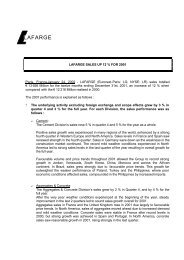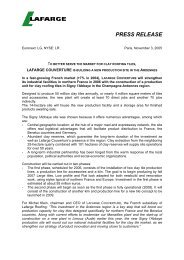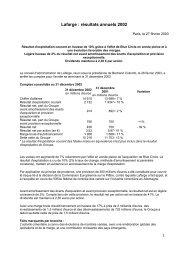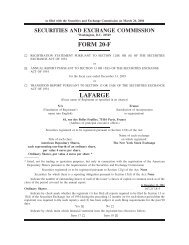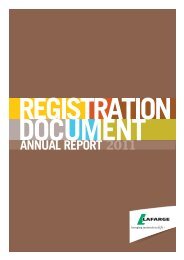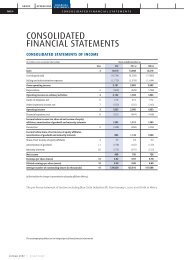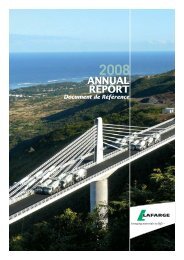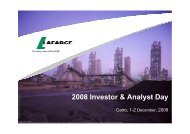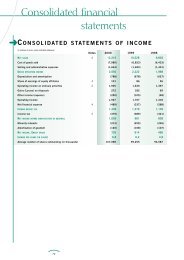2005 Sustainability Report - Lafarge
2005 Sustainability Report - Lafarge
2005 Sustainability Report - Lafarge
You also want an ePaper? Increase the reach of your titles
YUMPU automatically turns print PDFs into web optimized ePapers that Google loves.
Involvement of the Group in<br />
sustainable<br />
development<br />
Respect for the environment and local communities, as well as social advancement,<br />
are the factors preserving our license to operate and assuring a high standard of<br />
performance. We wish to share our convictions with other companies to encourage<br />
active participation in our industry's progress towards greater sustainability.<br />
OUR PRINCIPLES<br />
OF ACTION AND POLICIES<br />
FRAME OUR OPERATIONS<br />
Integrity, responsibility, courage and<br />
respect for others are the values underpinning<br />
our philosophy. They are embodied<br />
in our corporate commitments:<br />
• To generate value for our customers;<br />
• To give our employees every opportunity<br />
to contribute to the Group's success<br />
and to develop their talents;<br />
• To contribute to building a better<br />
world for our local communities;<br />
• To deliver the value creation that our<br />
shareholders expect.<br />
These commitments are listed in our<br />
Principles of Action enabling all our<br />
employees to situate their actions in a<br />
clear framework.<br />
The Group’s Principles of Action<br />
are available on our website.<br />
In addition, our policies govern the<br />
conduct of our operations and ensure<br />
compliance with our commitments, taking<br />
into account our sustainable development<br />
priorities: Code of Business Conduct,<br />
Competition Policy, Environmental Policy,<br />
Human Resources Policy, Employment<br />
CORNIS VAN DER LUGT (UNEP)<br />
Policy, Health and Safety Policy, Public<br />
Health and AIDS Guidelines, Purchasing<br />
Policy and Transportation Directives.<br />
The issues covered by the Group's various<br />
codes, policies, guidelines and directives are<br />
available on our website.<br />
In addition to the values defined<br />
internally by the Group, we have signed<br />
the Global Compact and its commitments<br />
are part of our guiding principles.<br />
The Group’s responses to the ten commitments<br />
set forth in the Global Compact are available<br />
on our website.<br />
LAFARGE'S CONTRIBUTIONS<br />
TO THE CEMENT<br />
INDUSTRY'S APPROACH<br />
In 2001, <strong>Lafarge</strong> embarked on its first<br />
voluntary initiative with WWF International<br />
by setting ambitious targets to reduce<br />
CO2 emissions from our cement plants.<br />
With two other cement companies and<br />
with a view to extend this type of initiative,<br />
<strong>Lafarge</strong> enrolled other companies in the<br />
sector that are members of WBCSD's 1<br />
Cement <strong>Sustainability</strong> Initiative (CSI). CSI<br />
was established in 2001 for an initial<br />
period of five years. Its objective is<br />
to establish conditions for a more<br />
sustainable development of the industry.<br />
This sectoral approach carries genuine<br />
legitimacy from the perspective of climate<br />
change and responsible and voluntary<br />
commitment. It extends beyond the scope<br />
of the Kyoto Protocol, as 6 of the 16 CSI<br />
members come from countries that have<br />
not committed to the protocol. Members<br />
of the CSI currently account for slightly<br />
more than half of the worldwide cement<br />
production (outside China).<br />
The CSI commitments are widely<br />
recognized, even beyond the confines of<br />
the cement sector. For instance, the Asia-<br />
Pacific Partnership on Clean Development<br />
and Climate 2 has identified the CSI as a<br />
key initiative and referred to it in one<br />
of its working groups. The State of<br />
California has adopted the methodology<br />
developed by the CSI for calculating CO2<br />
emissions for its register of emission<br />
quotas.<br />
<strong>Lafarge</strong> currently leads a CSI working<br />
group responsible for developing new<br />
initiatives for the CSI over the next few<br />
years.<br />
1 | WBCSD: World Business Council for Sustainable Development.<br />
2 | Asia-Pacific Partnership on Clean Development and Climate, an<br />
agreement signed by the United States, Japan, South Korea and<br />
Australia on research and technology sharing.<br />
You can make wonderful statements and public commitments to sustainable development and a corporate responsibility agenda.<br />
But if you don’t allocate clear responsibilities from top to bottom and engage all employees in the execution of strategy, the impressive statements<br />
and commitments will come to nothing. The introduction of a sustainable development committee with top management involvement, sustainability<br />
criteria in performance appraisals of managers, ongoing training of employees - suppliers and subcontractors – and annual reporting according to<br />
GRI… these are examples of how leading companies are making it happen. It is impressive to see how <strong>Lafarge</strong> is making the shift to sustainability<br />
performance, considering longer term risks and opportunities. As <strong>Lafarge</strong> expands its involvement in rapidly growing markets such as China, the Group<br />
needs to build on its experience and to support building the performing capacity of its new business partners. We also look forward to its continued<br />
engagement with other industries and partners in applying life cycle approaches for more sustainable building and construction.<br />
PANEL<br />
LAFARGE | <strong>2005</strong> SUSTAINABILITY REPORT | PAGE 03





